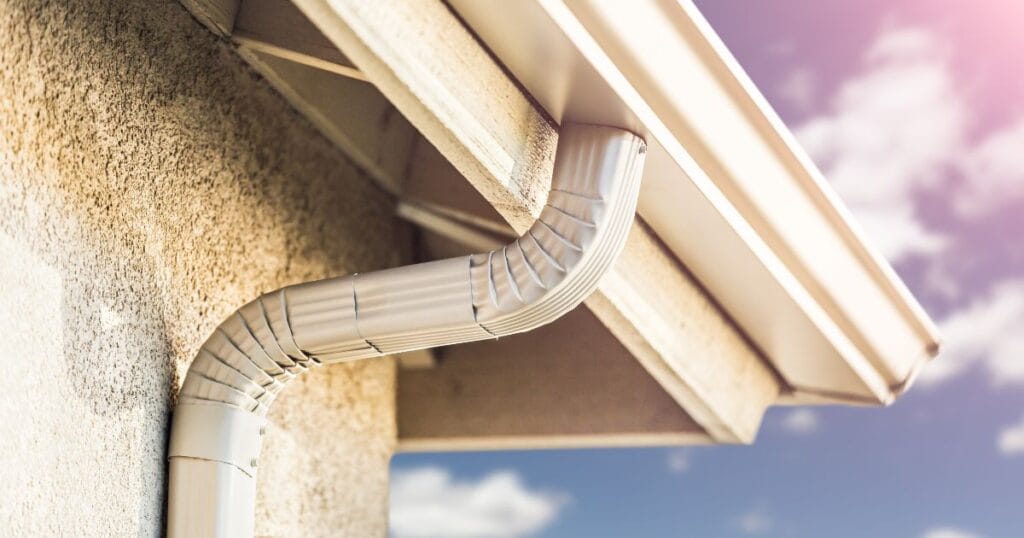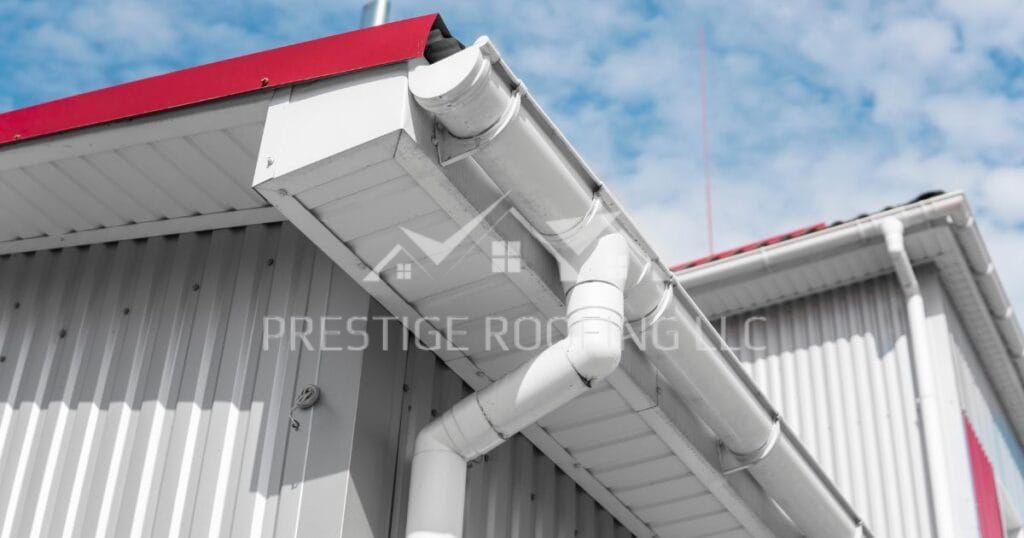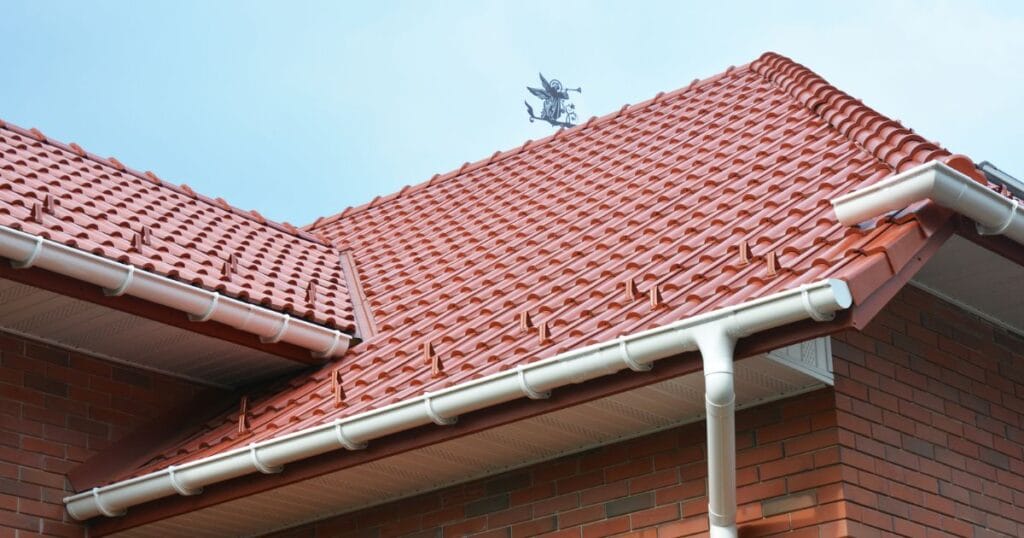Even though choosing gutters isn’t the most exciting part of a home improvement project, it’s crucial to keep the structure of your home stable and strong. We’ll go over some of the considerations you should keep in mind when choosing your gutter system in this comprehensive blog post to help you choose the best ones for your home.
What Are Gutters And Why Are They Important For Your Home?
Gutters are strategically installed along the roof’s edge to guide rainwater away from the walls and foundation. This not only prevents potential harm to the exterior, foundation, and roofing materials, but also helps avoid basement flooding, reduces mold and mildew risks, and improves the overall appearance of your home. By redirecting the flow of water, gutters contribute to leak prevention and extend the lifespan of your roof.
Regular maintenance, including clearing debris and fixing cracks or holes, is crucial to ensure their effectiveness and minimize the risk of flooding and other related issues.
What Are The Different Types Of Gutters?
Now that you know the importance of gutters, you’ll want to make a choice on gutter style, profile, and material when choosing the right gutters for your home. There are many different types of gutters, including:
#1. K-Style Gutters

K-style gutters, sometimes referred to as ogee gutters, are the most popular type of gutter style found on homes. Their back and bottom are flat, and they typically have a decorative shape on the front of the gutter that resembles crown molding.
They typically come in sizes ranging from 5 to 6 inches, and they frequently have rectangular-shaped downspouts. K-style gutters are simple and easy to install on your own, but cleaning their angle joints can be difficult since they tend to gather a lot of debris.
#2. Half-Round Gutters

A semicircular trough with a curved lip is a feature of half-round gutters. They work better with round downspouts because of this design. Their high level of popularity stems from their ease of upkeep and easy debris removal. In both traditional and modern settings, half-round gutters are also frequently used.
#3. Box Gutters
Box gutters are also referred to as square or trough gutters and are well-suited for modern buildings like apartment complexes and outbuildings because of their angular design. They are ideal for regions with large amounts of rainfall because they have a greater capacity to collect water. Box gutters are frequently made to order on-site to match the precise measurements of a structure.
#4. Fascia Gutters
Fascia gutters are seamless, modern gutters that are custom-built and found very rarely on homes. They are a unified system made up of both the fascia board and gutters. Although they provide a smooth, contemporary look, their price may be higher than that of other gutter styles.
#5. Seamless Gutters
Seamless gutters are designed specifically to match a structure’s measurements. One piece of material, which is cut to the precise length required on-site, is used to make seamless gutters, and with the reduced possibility of leaks, it’s no wonder they’re so popular. They do, however, cost more than sectional gutters, and require expert installation.
#6. Sectional Gutters

Smaller sections are connected together with connectors to form sectional gutters. They can be installed by DIY enthusiasts and are simpler to transport. However, their gutter seams may be susceptible to leaks.
What Are The Different Materials Gutters Are Made From?
There are several materials to choose from when it comes to gutters, and each has its own set of benefits and drawbacks. Here are the different materials gutters are made from:
#1. Aluminum
Aluminum gutters are favored for their lightweight nature, ease of installation, and diverse range of available colors. Notably, they possess rust-resistant properties, contributing to a lifespan of 30 years when properly maintained. This makes aluminum an excellent choice for those wanting a combination of practicality and longevity.
#2. Vinyl
Vinyl gutters stand out for their affordability, lightweight design, and straightforward installation process. However, their weakness lies in durability, especially in regions with really high humidity or frequent rainfall, where they may deteriorate quickly. Despite being a budget-friendly option, vinyl may not be the most resilient choice in wet climates.
#3. Steel
Steel gutters are robust and durable systems used to collect and channel rainwater away from roofs. They are known for their strength and ability to withstand harsh weather conditions. Coated for rust resistance, steel gutters require minimal maintenance and are suitable for areas with extreme weather. However, their weight may necessitate proper installation and support.
#4. Copper
Copper gutters present a durable and sophisticated choice, loaning an elegant touch to any building. With inherent rust resistance, copper gutters can last for up to a century with proper care. While they represent a premium selection, their longevity and aesthetic appeal make them a compelling option for those seeking both durability and style.
#5. Zinc
Zinc gutters share similarities with copper in terms of durability, environmental friendliness, and rust resistance. These gutters, with proper maintenance, can last up to 80 years. This makes zinc an appealing choice for individuals desiring longevity without compromising on eco-friendly considerations.
#6. Galvanized Steel
Galvanized steel gutters offer a low-maintenance solution coupled with ease of installation and rust resistance. The protective layer of zinc ensures resilience against rusting, adding to their longevity. This makes galvanized steel a practical option for those prioritizing durability and minimal upkeep.
Also Read: Roof 101: Your Pictorial Guide To The 19 Essential Parts Of A Roof
Factors To Consider When Choosing Gutters For Your Home
Here are some factors to keep in mind when choosing gutter systems for your home:
#1. Gutter Material
The choice of gutter material is a critical aspect of selecting an effective and durable gutter system. Different materials, such as aluminum, vinyl, copper, and steel, offer different advantages and drawbacks. The decision on material should align with a homeowner’s preferences and the specific demands of the local climate to ensure longevity and optimal performance.
#2. Climate Considerations
The climate in your region plays a huge role in figuring out what type of gutter material and profile is necessary. Analyzing factors like annual rainfall, snowfall, and temperature fluctuations is essential. In areas with heavy rainfall, it is advisable to opt for a gutter system with a higher capacity to manage the increase in water flow effectively. Considering the local climate ensures that the chosen gutters can handle specific weather conditions and prevent issues such as water overflow that could damage your home.
#3. Roof’s Pitch
Your roof’s pitch significantly influences the effectiveness of the gutter system. Steeper roof slopes facilitate better water flow, aiding in the removal of debris. However, excessively steep pitches can pose challenges. The roof’s pitch also dictates the width of the gutters and impacts the efficiency of downspouts. Careful consideration of the roof’s pitch is necessary to ensure proper water drainage and stop potential problems related to water accumulation and debris buildup.
#4. Maintenance
Maintenance required for the gutter system is a crucial consideration for homeowners. Some gutter designs may demand more frequent maintenance due to their shape or susceptibility for debris buildup. To mitigate maintenance efforts, installing a high-quality gutter guard is recommended. This additional measure can effectively reduce the need for regular cleaning and enhance the overall longevity and efficiency of the gutter system.
#5. Aesthetics
Your chosen gutter system should harmonize with the overall design of the home. Various gutter styles, such as K-style, half-round, and box gutters, offer different visual impacts. When choosing a gutter design, it is crucial to consider the architectural style of the home. A well-matched gutter system enhances the overall curb appeal and complements the aesthetic features of your home.
#6. Longevity
The longevity of the chosen gutter material is a key factor influencing the overall lifespan of the gutter system. Materials like copper are renowned for their durability, capable of lasting for decades. Conversely, other materials may have a shorter lifespan. Considering long-term maintenance and replacement costs is essential when evaluating the longevity of the gutter system. This ensures that homeowners make informed decisions that align with their budget and long-term maintenance expectations.
#7. Gutter Size
Choosing the appropriate size for your gutter channels is crucial for efficient water management. The size should be tailored to the expected water flow in the area, aligning with local weather conditions. Ensuring that the gutter system can handle the water flow prevents issues such as overflow and water damage. Careful evaluation of gutter size is fundamental in optimizing the functionality of the gutter system.
#8. Gutter Design
Different gutter designs have distinct capabilities in managing water flow and preventing debris buildup. For example, K-style gutters offer a streamlined appearance and efficient water flow, while half-round gutters are less prone to debris accumulation due to their shape. Understanding the features and benefits of different designs allows homeowners to select gutters that align with their preferences and the unique requirements of their property.
How To Maintain Your Gutters
#1. Regular Cleaning
Clean gutters twice a year (spring and fall) to remove debris, ensuring proper water flow and preventing damage like overflow and leaks.
#2. Inspect for Blockages
Regularly check for debris blocking gutters to prevent clogs, ensuring efficient drainage and minimizing the risk of water damage.
#3. Test for Leaks
It’s essential to do routine checks for leaks, especially after storms. Prompt repairs prevent water damage, protecting against structural damage and mold growth.
#4. Secure Your Gutters
Ensure proper gutter attachment to prevent sagging or detachment. Regularly secure gutters and address signs of instability to maintain structural integrity.
#5. Keep on Top of Repairs
Swiftly address gutter issues, like loose brackets or damaged sections, to extend the system’s longevity and prevent costly repairs.
#6. Consider Installing Gutter Guards
Install gutter guards to prevent debris entry, reducing the likelihood of clogs and making cleaning more manageable, particularly in foliage-heavy areas.
#7. Install Downspout Extensions
Use downspout extensions to push water away from the foundation of your home, preventing foundation damage and potential flooding. Proper water diversion safeguards against structural and landscape issues.
Neglecting gutter maintenance leads to severe consequences, such as expensive repairs and pest infestations. Regular cleaning, inspections, and proactive measures like gutter guards and downspout extensions contribute to the overall health and longevity of the system.
If tackling gutter maintenance seems challenging, consider hiring a professional service for thorough and safe cleaning.
How To Clean Gutters
To clean gutters, you can follow these steps for an effective and safe process:
Step1: Prepare for the Job:
- Wear protective gear, including non-slip footwear, gloves, and eye protection.
- Use a secure ladder with a spotter for safety.
Step 2: Remove Debris:
- Scoop out gutter debris with hands, a narrow trowel, or a gutter scoop.
- Clear downspouts and gutters of clogs.
Step 3: Clean the Gutters:
- Flush gutters with a hose after removing large debris.
- Use a pressure washer or power blower for thorough cleaning.
Step 4: Install Gutter Guards:
- Consider installing guards to prevent future debris buildup.
Step 5: Final Steps:
- Clean up ground debris with a rake or leaf blower.
- Dispose of debris in a leaf bag for proper cleanup.
How To Install Gutters
Though professional gutter installation is always recommended, if you choose to install a gutter system such as sectional gutters yourself, you should follow these steps:
#1. Safety Precautions:
Prioritize safety with necessary equipment like a harness to prevent falls during installation.
Gather Your Materials: Start by gathering all the necessary materials and tools for the installation, including the gutter sections, downspouts, hangers, screws or nails, gutter sealant, a ladder, a level, a hacksaw, and a drill.
#2. Plan Your Layout:
Determine the best placement for your gutters, ensuring they slope slightly toward the downspouts for proper drainage. Measure and mark the locations for the downspouts and the placement of gutter hangers along the fascia board.
#3. Install the Downspouts:
Begin by attaching the downspouts to the corners of your home, securing them with screws or brackets. Make sure they slope away from the foundation.
#4. Hang the Gutters:
Install the gutter hangers at the marked locations, ensuring they are level and properly spaced. Sectional gutters typically snap into the hangers or are screwed in place.
#5. Connect Sections:
Assemble the gutter sections by snapping or connecting them together, ensuring a snug fit. Use a hacksaw to trim sections as needed to fit the desired length.
#6. Attach End Caps:
Place end caps at each open end of the gutter sections to prevent water from escaping.
#7. Seal Joints:
Apply gutter sealant to the joints between the sections to prevent leaks. Make sure to follow the manufacturer’s instructions for the sealant.
#8. Secure and Test:
Secure the gutters firmly to the hangers using screws or nails. Test the slope by pouring water into the gutter to ensure it flows toward the downspouts.
#9. Install Downspout Extensions:
If necessary, add downspout extensions to direct water away from your home’s foundation.
#10. Inspect and Clean:
Give your installation a final inspection to ensure everything is secure and functional. Remove any debris or excess sealant.
Need Help With Choosing the Right Gutters for Your Home?
As a homeowner, it’s important to carefully consider material, size, and maintenance factors when selecting gutters for your home. Don’t be afraid to ask Prestige Roofing for individualized guidance if you’re unclear about the best options for your particular needs.
Get your roofing project going with our free estimate and inspection with our experienced team who has over 50 years of combined experience, and is ready to handle all your gutter needs. We focus on keeping you happy with project managers who are there to answer your questions and keep you in the loop. Plus, you can have added peace of mind with our 10-year warranty that protects your investment. Give us a call today at (920) 791-0414 to learn more!

